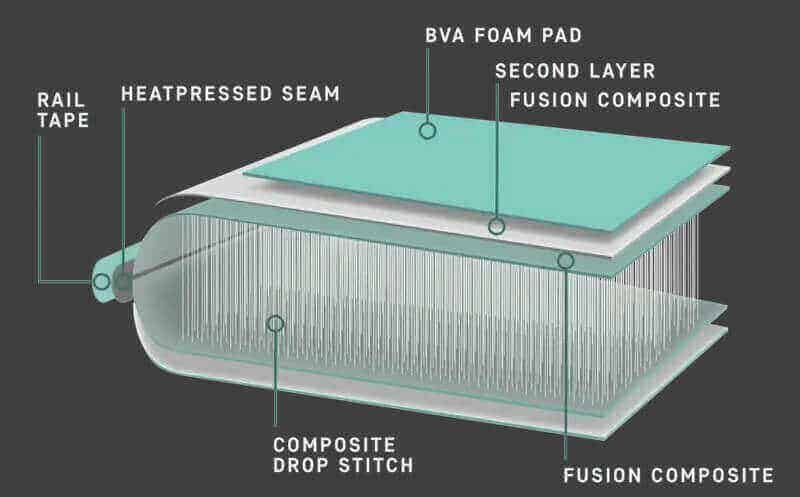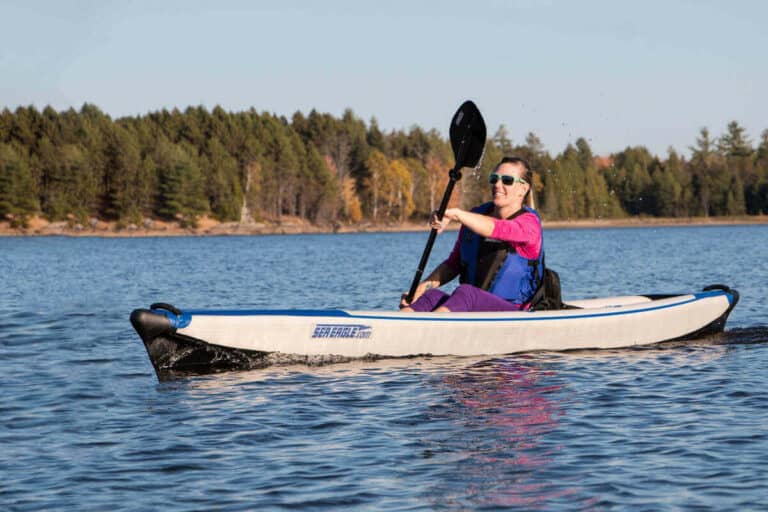Disclosure: I am compensated for purchases made through some links on this site. Click for details.
Inflatable kayaks have rapidly gained popularity in recent years due to their portability, ease of use, and affordability. One of the most innovative advancements in inflatable kayak technology is the drop-stitch construction. Drop-stitch inflatable kayaks offer a high level of rigidity, performance, and stability, making them a preferred choice for many kayakers.
Drop-stitch technology involves using thousands of tiny threads to connect the top and bottom layers of the inflatable kayak. This creates a framework of sorts that is then filled with air, resulting in an incredibly rigid structure that is capable of withstanding high levels of pressure. The result is a kayak that is much sturdier and more stable than traditional inflatable kayaks.
Key Takeaways
- Drop-stitch technology uses thousands of tiny threads to create a framework that is then filled with air, resulting in an incredibly rigid structure.
- Drop-stitch inflatable kayaks are sturdier and more stable than traditional inflatable kayaks, making them a preferred choice for many kayakers.
- Drop-stitch inflatable kayaks are portable, easy to use, and affordable, making them a popular choice among kayakers.
Concept of Drop-Stitch Technology

Definition of Drop-Stitch
Drop-stitch technology is a method of constructing inflatable objects, such as kayaks, paddleboards, and boats, that creates a more rigid structure than traditional inflatable designs. The process involves thousands of tiny threads, called “stitches,” that connect the top and bottom layers of the inflatable air chamber equidistant from each other. Compared to traditional inflatable kayaks with I-beam construction, where all surfaces are rounded, drop-stitch technology results in a flatter surface that can be inflated to rock-hard rigidity.
Key Features of Drop-Stitch Technology
| Feature | Benefit |
|---|---|
| Threaded Structure | Thousands of threads connect top and bottom layers |
| High Air Pressure | Allows kayak to be more rigid than standard inflatables |
| Durability | Resistance to punctures and wear |
| Stability | Enhanced by the rigidity and firmness of the structure |
History and Evolution
The use of drop-stitch technology in the construction of inflatable objects dates back to the 1960s, when it was first used in the production of inflatable rescue boats for the military. Since then, the technology has evolved and been refined, leading to the development of a wide range of inflatable products that utilize drop-stitch construction. Today, drop-stitch inflatable kayaks are becoming increasingly popular among outdoor enthusiasts due to their lightweight, portable design and superior performance compared to traditional inflatable kayaks.
In recent years, drop-stitch technology has continued to evolve, with manufacturers incorporating new materials and design features to further enhance the performance and durability of their products. For example, some drop-stitch kayaks now feature a chine, which is a sharp angle in the hull that improves stability and tracking. Other innovations include the use of advanced fabrics and coatings that provide additional protection against punctures, abrasions, and UV damage.
Overall, the concept of drop-stitch technology has revolutionized the world of inflatable products, allowing for the creation of more durable, high-performance designs that can rival the performance of traditional hard-shell boats and kayaks.
Design and Construction of Inflatable Kayaks
Materials Used
Inflatable kayaks are typically made of PVC or vinyl material, which is lightweight and durable. PVC is a synthetic plastic polymer that is commonly used in various products, including inflatable kayaks. It is known for its strength, durability, and resistance to abrasion, punctures, and UV rays. Vinyl, on the other hand, is a plastic material that is also lightweight and durable. It is often used as a coating or laminate over PVC or nylon material to provide extra strength and protection.
In addition to PVC and vinyl, inflatable kayaks also use other materials such as nylon, polyester, and drop-stitch fabric. Nylon and polyester are commonly used as the base fabric for inflatable kayaks. They are lightweight, strong, and abrasion-resistant. Drop-stitch fabric, on the other hand, is a high-density fabric that is used to create a rigid and stable hull. It is made by stitching together two layers of fabric with thousands of tiny threads, which creates a grid-like pattern of small pockets that can be filled with air.
Manufacturing Process
The manufacturing process of inflatable kayaks involves several steps, including cutting, welding, and stitching. The first step is to cut the base fabric into the desired shape and size. The seams are then welded together using heat and pressure to create a watertight seal. The drop-stitch fabric is then added to the bottom of the kayak to create a rigid and stable hull.
Once the kayak is assembled, it is inflated using a pump. Most inflatable kayaks have multiple air chambers, which provide added safety in case of a puncture or leak. The air chambers are typically located in the hull, floor, and sides of the kayak. The inflation process can take anywhere from a few minutes to 30 minutes, depending on the size of the kayak and the type of pump used.
Overall, the design and construction of inflatable kayaks make them a popular choice for recreational paddlers who want a lightweight, portable, and affordable option for exploring the water.
Advantages of Drop-Stitch Kayaks
Drop-stitch kayaks have several advantages over traditional inflatable kayaks. Below are some of the most notable benefits.
Durability
Drop-stitch kayaks are more durable than traditional inflatable kayaks. This is because they are made with a special construction technique that involves thousands of tiny threads connecting the top and bottom layers of the kayak. This construction technique makes the kayak more rigid and less likely to puncture or tear.
Stability
Drop-stitch kayaks are more stable than traditional inflatable kayaks. This is because they can hold a higher PSI when fully inflated, which makes them sturdier and less likely to tip over. Additionally, drop-stitch kayaks often have a wider base than traditional inflatable kayaks, which provides more stability in the water.
Portability
Drop-stitch kayaks are highly portable. They are lightweight and easy to deflate, which makes them easy to transport and store. Additionally, many drop-stitch kayaks come with a carrying bag, which makes it even easier to take them on the go.
Advantages of Drop-Stitch Kayaks
| Advantage | Description |
|---|---|
| Durability | More resistant to punctures and tears due to thread-reinforced structure |
| Stability | Higher PSI capacity ensures better stability and balance |
| Portability | Lightweight and easy to deflate for transport and storage |
In summary, drop-stitch kayaks are more durable, stable, and portable than traditional inflatable kayaks. These advantages make them a popular choice for kayakers who want a high-quality, easy-to-use kayak that can withstand the rigors of the water.
Types of Drop-Stitch Kayaks
Drop-stitch kayaks come in a variety of types, each designed for a specific purpose. The following are the most common types of drop-stitch kayaks:
Recreational Kayaks
Recreational drop-stitch kayaks are designed for casual paddling on calm waters such as lakes and slow-moving rivers. They are typically wider and shorter than touring kayaks, making them more stable and easier to maneuver. Recreational kayaks often have a larger cockpit opening, making it easier to get in and out of the kayak. They also tend to have more comfortable seats and backrests for longer paddling sessions.
Touring Kayaks
Touring drop-stitch kayaks are designed for longer trips on open water such as the ocean or large lakes. They are longer and narrower than recreational kayaks, making them faster and more efficient at covering longer distances. Touring kayaks have a smaller cockpit opening, which helps to reduce drag and increase speed. They also tend to have more storage space for gear and supplies needed for longer trips.
Whitewater Kayaks
Whitewater drop-stitch kayaks are designed for navigating rapids and fast-moving water. They are shorter and more maneuverable than recreational and touring kayaks, making them easier to control in turbulent water. Whitewater kayaks often have a more aggressive rocker profile, which helps to keep the kayak stable and prevent it from flipping over in rapids.
Fishing Kayaks
Fishing drop-stitch kayaks are designed for anglers who want to fish from a kayak. They are typically wider and more stable than other types of kayaks, making it easier to stand up and cast a fishing line. Fishing kayaks often have built-in rod holders, storage compartments for gear and tackle, and other features that make them more suitable for fishing.
Comparison of Kayak Types
| Type | Ideal Use | Length | Width | Key Features |
|---|---|---|---|---|
| Recreational | Calm waters, lakes, slow rivers | Shorter, wider | More stability | Larger cockpit, comfortable seats, easy maneuvering |
| Touring | Open water, longer trips | Longer, narrower | Faster | Smaller cockpit, more storage, efficient tracking |
| Whitewater | Rapids, fast-moving water | Short, maneuverable | Agile | Aggressive rocker profile, stable in rapids |
| Fishing | Fishing activities | Wide, stable | Ample space | Rod holders, storage compartments, stable platform |
In summary, drop-stitch kayaks come in a variety of types, each designed for a specific purpose. Recreational kayaks are ideal for casual paddling on calm waters, while touring kayaks are designed for longer trips on open water. Whitewater kayaks are designed for navigating rapids and fast-moving water, and fishing kayaks are designed for anglers who want to fish from a kayak.
Usage and Performance
On-Water Experience
Drop-stitch inflatable kayaks are designed to provide a high-performance paddling experience that rivals that of hard-shell kayaks. The kayaks are lightweight, easy to transport, and inflate to a rigid structure that offers stability and maneuverability on the water. The drop-stitch construction allows for higher air pressure, which results in a more rigid structure that can withstand the rigors of paddling in various water conditions.
Due to their lightweight and compact design, drop-stitch inflatable kayaks are a popular choice for recreational paddlers who enjoy exploring calm lakes and rivers. The kayaks are also suitable for more adventurous paddlers who want to tackle rapids and rougher water conditions. The inflatable design allows for easy portability, making it possible to transport the kayak to remote locations that are inaccessible to hard-shell kayaks.
Suitability for Various Water Conditions
Drop-stitch inflatable kayaks are suitable for a wide range of water conditions, including calm lakes, slow-moving rivers, and even mild whitewater rapids. The kayaks are designed to be stable and maneuverable, which makes them a great choice for beginners and experienced paddlers alike.
When paddling in calm water conditions, the drop-stitch inflatable kayak offers a smooth and comfortable ride. The kayak tracks well and is easy to maneuver, making it possible to explore the waterways with ease. When paddling in rougher water conditions, the kayak remains stable and responsive, allowing paddlers to navigate through rapids and choppy water with confidence.
In summary, drop-stitch inflatable kayaks are a versatile and high-performing option for paddlers who want the convenience and portability of an inflatable kayak without sacrificing performance on the water.
Kayak Performance on Various Water Conditions
| Water Condition | Performance |
|---|---|
| Calm Lakes | Smooth, comfortable ride, easy maneuverability |
| Slow-Moving Rivers | Stable, tracks well, good for beginners |
| Mild Whitewater | Responsive, stable in choppy water |
Maintenance and Care
Drop-stitch inflatable kayaks require proper maintenance and care to ensure their longevity. This section will cover some essential tips to help maintain and care for your drop-stitch inflatable kayak.
Cleaning and Storage
Cleaning your drop-stitch inflatable kayak is crucial to prevent damage caused by dirt, sand, and other debris. After each use, rinse the kayak with freshwater to remove any salt or sand. Use a mild soap and a soft brush to scrub the kayak’s surface gently. Rinse the kayak again with freshwater and let it dry completely before storing it.
When storing your drop-stitch inflatable kayak, ensure it is completely dry to prevent mold and mildew growth. Store the kayak in a cool, dry place away from direct sunlight. Avoid storing the kayak in a folded position for an extended period, as this can cause creases that may damage the kayak’s structure.
Repair and Maintenance Tips
Regular maintenance of your drop-stitch inflatable kayak is essential to prevent any damage. Inspect the kayak for any punctures, cuts, or abrasions before and after each use. If there are any damages, repair them immediately using a repair kit.
To maintain the kayak’s shape and performance, ensure that it is inflated to the recommended pressure. Overinflation or underinflation can cause damage to the kayak’s structure. Use a pressure gauge to measure the kayak’s pressure accurately.
In conclusion, proper maintenance and care are essential to ensure the longevity of your drop-stitch inflatable kayak. Regular cleaning, proper storage, and regular inspections can help prevent damage and prolong the kayak’s lifespan.
Maintenance and Care Tips
| Task | Details | Frequency |
|---|---|---|
| Cleaning | Rinse with freshwater, mild soap, and soft brush | After each use |
| Drying and Storage | Dry completely, store in cool, dry place away from sunlight | As needed |
| Inspection and Repair | Check for punctures or abrasions, repair immediately | Before/after each use |
Safety Considerations
When it comes to inflatable kayaks, safety should always be a top priority. Here are a few safety considerations to keep in mind:
Proper Use
It is important to use the drop-stitch inflatable kayak properly to ensure safety. The user should always follow the manufacturer’s instructions for inflating, deflating, and using the kayak. Overinflating the kayak can cause it to burst, while underinflating it can make it unstable and difficult to control.
Additionally, it is important to use the kayak in appropriate water conditions. Drop-stitch inflatable kayaks are best suited for calm waters such as lakes, ponds, and slow-moving rivers. Using them in rough waters or strong currents can be dangerous.
Equipment Checklist
Before heading out on the water with a drop-stitch inflatable kayak, it is important to have the proper equipment. Here is a checklist of essential items:
- Personal flotation device (PFD)
- Paddle
- Pump
- Repair kit
- Whistle
- Sun protection (hat, sunglasses, sunscreen)
It is also a good idea to bring along a waterproof bag to store any valuables or electronics.
By following these safety considerations and using the proper equipment, users can enjoy a safe and enjoyable kayaking experience with a drop-stitch inflatable kayak.
Safety Equipment Checklist
| Equipment | Description |
|---|---|
| Personal Flotation Device (PFD) | Essential for safety on water |
| Paddle | Appropriate for kayak type and user size |
| Pump | For inflating the kayak to the correct pressure |
| Repair Kit | Necessary for on-the-spot repairs |
| Whistle | For signaling in case of emergency |
| Sun Protection | Hat, sunglasses, sunscreen for UV protection |
Buying Guide
Factors to Consider
When choosing a drop-stitch inflatable kayak, there are several factors to consider to ensure that you end up with the best product for your needs. One of the most important factors is the intended use of the kayak. Different kayaks are designed for different activities, such as touring, fishing, or whitewater paddling. It’s important to choose a kayak that is specifically designed for the activity you plan to use it for to ensure optimal performance.
Another factor to consider is the size and weight of the kayak. The size of the kayak will determine how many people can comfortably fit in it, while the weight will determine how easy it is to transport and store. It’s important to choose a kayak that is the right size and weight for your needs.
The material used to make the kayak is another important factor to consider. Drop-stitch kayaks are typically made from PVC or other durable materials that can withstand the rigors of outdoor use. It’s important to choose a kayak that is made from high-quality materials to ensure that it will last for many years.
Comparing Brands and Models
When comparing different brands and models of drop-stitch inflatable kayaks, there are several factors to consider. One of the most important factors is the price. Drop-stitch kayaks can range in price from a few hundred dollars to several thousand dollars, depending on the brand and model. It’s important to choose a kayak that is within your budget.
Another factor to consider is the features of the kayak. Some kayaks come with built-in storage compartments, while others have adjustable seats or footrests. It’s important to choose a kayak that has the features that are most important to you.
Finally, it’s important to read reviews from other customers to get an idea of the quality of the kayak. Look for kayaks that have high ratings and positive reviews from other customers to ensure that you are getting a high-quality product.






